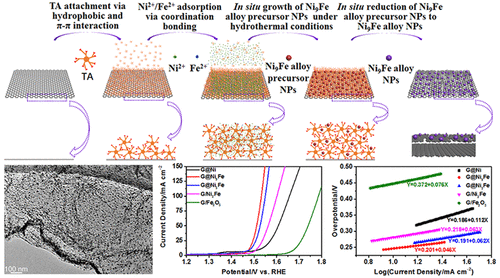当前位置:
X-MOL 学术
›
ACS Appl. Energy Mater.
›
论文详情
Our official English website, www.x-mol.net, welcomes your feedback! (Note: you will need to create a separate account there.)
Tannic Acid-Mediated In Situ Controlled Assembly of NiFe Alloy Nanoparticles on Pristine Graphene as a Superior Oxygen Evolution Catalyst
ACS Applied Energy Materials ( IF 6.4 ) Pub Date : 2020-03-31 00:00:00 , DOI: 10.1021/acsaem.0c00362 Ming Zhao 1, 2 , Huilin Li 3 , Weiyong Yuan 1, 2 , Chang Ming Li 1, 2
ACS Applied Energy Materials ( IF 6.4 ) Pub Date : 2020-03-31 00:00:00 , DOI: 10.1021/acsaem.0c00362 Ming Zhao 1, 2 , Huilin Li 3 , Weiyong Yuan 1, 2 , Chang Ming Li 1, 2
Affiliation

|
Controlled assembly of small and highly dispersed earth-abundant transition metal-based oxygen evolution reaction (OER) catalysts on pristine graphene could greatly boost the OER efficiency while significantly reducing the cost, but this presents great challenges. Pristine graphene (rather than reduced graphene oxide or graphene with a damaged electronic structure) supported NiFe alloy nanoparticles (NPs) have been synthesized for the first time via tannic acid (TA)-mediated in situ controlled assembly, in which TA not only noncovalently modifies the graphene to strongly coordinate with Ni2+ and Fe2+ but also in situ reduces these metal ions to alloy NPs. The chemical composition of these alloy NPs can be tailored via changing the ratio of Ni2+ and Fe2+ in the reaction. These nanohybrids show ultrahigh and tunable OER catalytic activities. The optimum one obtained using the ratio of 9:1 achieves 10 mA cm–2 at an overpotential of 246 mV and shows a Tafel slope of 46 mV dec–1, both of which are lower than those of most reported OER catalysts, including state-of-the-art Ru- and Ir-based ones. In addition, this catalyst exhibits little change of the overpotential after 20 h of chronopotentiometric measurement (from 246 to 258 mV at 10 mA cm–2) and negligible current loss after 1000 CV cycles (from 123.3 to 133.4 mA cm–2 at 1.54 V). The superior catalytic activity and durability are ascribed to the in situ assembled small, highly dispersed, and highly conductive NiFe alloy NPs on pristine graphene significantly facilitating the electron transfer and increasing the electrochemically accessible active sites, the doped FeOOH remarkably promoting the intrinsic activity of Ni(OH)2 on the surface of these alloy NPs, and the robust in situ growth greatly enhancing the durability during the OER testing. This work provides a green, facile, and economical strategy to controllably fabricate low-cost and high-performance OER catalysts and also sheds light on the performance enhancement mechanism from tunable OER catalytic activity.
中文翻译:

单宁酸介导的NiFe合金纳米颗粒在原始石墨烯上的原位控制组装作为一种优良的析氧催化剂
在原始石墨烯上对高度分散的小且高度分散的基于地球的过渡金属氧分解反应(OER)催化剂的控制组装可以大大提高OER效率,同时显着降低成本,但这带来了巨大挑战。最初通过单宁酸(TA)介导的原位控制组装合成了原始石墨烯(而不是还原的氧化石墨烯或具有损坏的电子结构的石墨烯)负载的NiFe合金纳米颗粒(NPs),其中TA不仅非共价改性石墨烯强烈与倪协调2+和Fe 2+,而且在原位将这些金属离子还原为合金NP。这些合金NP的化学组成可以通过改变反应中Ni 2+和Fe 2+的比例来调整。这些纳米杂化物显示出超高且可调节的OER催化活性。使用9:1的比例获得的最佳溶液在246 mV的超电势下达到10 mA cm –2,并且Tafel斜率为46 mV dec –1,二者均低于大多数报道的OER催化剂(包括态)最先进的Ru和Ir型合金。此外,该催化剂在计时电位测量20小时后(10 mA cm –2时从246 mV至258 mV )几乎没有过电位变化,在1000 CV循环后(123.3 to 133.4 mA cm)电流损失可忽略不计在1.54 V时为–2)。优异的催化活性和耐久性归因于原始石墨烯上原位组装的小型,高分散性和高导电性的NiFe合金NP,显着促进了电子转移并增加了电化学可及的活性位,掺杂的FeOOH显着促进了Ni的固有活性(OH)2在这些合金NP的表面上,并且强大的原位生长大大增强了OER测试期间的耐久性。这项工作提供了一种绿色,简便且经济的策略,可控制地制造低成本和高性能的OER催化剂,并且通过可调节的OER催化活性揭示了性能增强机制。
更新日期:2020-03-31
中文翻译:

单宁酸介导的NiFe合金纳米颗粒在原始石墨烯上的原位控制组装作为一种优良的析氧催化剂
在原始石墨烯上对高度分散的小且高度分散的基于地球的过渡金属氧分解反应(OER)催化剂的控制组装可以大大提高OER效率,同时显着降低成本,但这带来了巨大挑战。最初通过单宁酸(TA)介导的原位控制组装合成了原始石墨烯(而不是还原的氧化石墨烯或具有损坏的电子结构的石墨烯)负载的NiFe合金纳米颗粒(NPs),其中TA不仅非共价改性石墨烯强烈与倪协调2+和Fe 2+,而且在原位将这些金属离子还原为合金NP。这些合金NP的化学组成可以通过改变反应中Ni 2+和Fe 2+的比例来调整。这些纳米杂化物显示出超高且可调节的OER催化活性。使用9:1的比例获得的最佳溶液在246 mV的超电势下达到10 mA cm –2,并且Tafel斜率为46 mV dec –1,二者均低于大多数报道的OER催化剂(包括态)最先进的Ru和Ir型合金。此外,该催化剂在计时电位测量20小时后(10 mA cm –2时从246 mV至258 mV )几乎没有过电位变化,在1000 CV循环后(123.3 to 133.4 mA cm)电流损失可忽略不计在1.54 V时为–2)。优异的催化活性和耐久性归因于原始石墨烯上原位组装的小型,高分散性和高导电性的NiFe合金NP,显着促进了电子转移并增加了电化学可及的活性位,掺杂的FeOOH显着促进了Ni的固有活性(OH)2在这些合金NP的表面上,并且强大的原位生长大大增强了OER测试期间的耐久性。这项工作提供了一种绿色,简便且经济的策略,可控制地制造低成本和高性能的OER催化剂,并且通过可调节的OER催化活性揭示了性能增强机制。



























 京公网安备 11010802027423号
京公网安备 11010802027423号